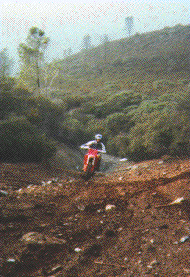

SLIPPING that clutch - Do bikes have automatic transmissions?
DISCOVER "The magic of a two-stroke."

Eric Mashbir
There were three women in our group of 13. People ranged from those who'd only been dirtriding a few times to guys in full moto regalia hoping to improve their motocross skills. Ages were from about ten(?) to maybe 55. Bikes were mostly two-strokes, with three XR250's thrown in. There were two father/son duos, one son being about ten, on a Suzi minibike. The little guy did it all, including the jump into a river bed! (Dry).
Doc Wong made like a rabbit and disappeared up some steep hills when he got bored with practicing. Made it look easy.

I took written notes during the day. This is a summary for the other riders and those who did not attend if they are interested. In my opinion it was an A+ day. Eric didn't just ride around with the rest of us desperately trying to keep up, but taught the whole day. The format was based on addressing a set of dirt riding skills. First, Eric would explain how to and how not to. Then he would demonstrate with at least one demonstration per skill at high speed resulting in audible amazement from the collected students. We would each perform the skill and he would critique us individually. We assembled at Carnegie at 9:00 and started instructions a little before 10:00 finishing at 5:30.
We started with a demonstration of riding position using Eric's bike on a stand. The emphasis is on standing up. Eric stresses standing up in almost all situations. He sits in the apex of a turn but in any difficult terrain, stand up. Smooth roads, well, ok sit. Pivot point is the footpegs, legs are like extra shock absorbers, arms are like extra front forks, knees and elbows bent. Knees locked into the tank, head forward of your centerline and butt to the rear about an equal amount. Hip to shoulders are straight. You should be balanced fore and aft and side to side. Look ahead not at your front fender. You should be looking where you will have time to react. If your legs burn, lock your knees more to take some load off. Grip handle bars with index and/or middle finger covering your brake and clutch. Emphasis on keeping the brake lever covered for fast reaction; don't grip the bar with all four fingers. Don't grip the bar hard, the v from thumb to index finger on each side can maintain control most of the time. Obviously, more grip in bad ruts, etc. Try to keep wrists straight, not cocked up or down. My nemisis, covering the brake is new, I realize now that I am cocking my wrist up to reach it. If I lose my balance at all backward or even big bumps on cobbles I straighten my arm which uncocks my wrist which turns on the throttle which on a new ATK 600 is one hell of a burst forward which throws me more back which causes me to straighten more which causes more throttle which - aaarrrgggg!
This should facilitate standing up without comprimising sitting down. Most of us moved our bars up somewhat from where we had them. One way of judging is sighting directly from the side. The upward taper of the bar should be about parallel with the fork (works on Answer and ProTaper). The result is the actual grips are still basically level but the bar is a little forward and up. My Answer bar ended up on the -1 setting (its marked near the triple clamp.)
both should be slightly down. It's a compromise between standing and sitting - personal preference.
Up about 1 to 1 1/2 inches from footpeg top. This is to keep your toe from going to low when up shifting and getting caught by a hard object and pulled under the peg - not pleasant. This will make you raise your foot slightly to downshift.
Even with the footpeg and not much play to engagement again to protect your foot. Do not put it higher than the footpeg so that you don't ride it and thus heat up and lose the rear brake.
Its been said that Motul 300c is the best. Eric changes his brake fluid before every race.
Stopping comes from 70% front, 30% back; use both. Not using the rear brake will cause the bike to spin around as the back catches up with the front. Keep body position back so your arms can take the load; don't sit. We practiced this on a level spot accelerating to a cone and stopping before the next cone.
This was done in two stages; a series of tight turns and another drill with a sweeping turn. Again, in the same level area. Conditions were hardpan with loose stuff on top so slippery and not very good. Some points:
Don't brake in the corner, finish before it.
In Apex sit down, weight is forward on the bike.
OK to put your inside foot out and to the front; use it if you need it.
Sit on the outside (of the turn) of the bike. Weight on the outside footper. Bike leans in.
Pick a good line; outside, in to the apex and back out again.
In the higher speed sweeper, get the corner finished and the bike aimed where you want to go before turning on the gas; don't spin out sideways. Eric went through this one so fast it was hard to believe. When he got done he said he hit it just right; about as good as he could do - I agree.

This was a fairly easy hill without whoops; emphasis on technique and allowing all the riders to do it. Points:
Going up - body weight forward; don't sit but your butt is only a few inches off the seat; you are not standing way up in the air.
Maintain momentum, the main thing behind successful hill climbing. Get as much speed as possible before starting up.
Shift as you go up before you bog. If you start to bog you will not make it.
Throttle control - try not to spin the rear wheel; it will just lose traction.
Body weight back. Still standing up but butt is off the back of the bike. Arms are almost straight taking the load but don't totally lock your elbows.
Apply both front and back brake. The back brake stabilizes the bike on the way down. The front brake provides most of the braking power.
Doc Wong led this one, and the intent was to encourage us to let the bikes' front wheel follow the rut. I couldn't get comfortable with this one.
Eric's demonstrations were sensational, he made it look so easy, and for the last hourray he showed us how to jump off a six foot drop. I was certain he was going to crash and die but he flew over the drop like it was a small bump. Luckily, we were assigned a much smaller "cliff", a one footer, which still scared the bejesus out of me.
In order to do thejump though, we had to wheelie just before lauching over the cliff. Several of us , me included, were wheelie challenged so Eric gave us a brief lesson. Though I had tried several times before on my ZX6, XT350 and lately the R1100GS I was never able to wheelie for the life of me. Needless to say I felt very diminished by it. A few tries after Eric's lesson I was pulling my front wheel like a charm, the man is a genius. Of course I attribute the success to my own abilities and not the KTM's torque.
Suddenly the one foot drop was no more a challenge and I was flying over the ledge. Well I'm only slightly exagerating here; since my wheelies are still not very well controlled, most of the time I just slid over the one foot drop. But hey I can wheelie now, so there. Eric demonstrated drops on a hill with a ledge caused by a cross path. This one really did get an audible gasp from the troops. Both going up and down that hill he was more in the air than on the ground. We practiced on the level with only a 1 foot drop so that if you blew the technique, no damage done.
The secret to drop offs is to do a small wheelie just before you get to it. You want to keep the front tire up when you land; preferably with the rear tire hitting slightly first. The more momentum you have the easier the landing; however, know what you are landing in and judge speed to fit the situation.
Eric demonstrated a faster way to go over small bumps of a foot or two.
Don't hit it with your front tire and jump. Instead, wheelie your front
wheel over it letting the back wheel hit. This will put the bike right
back down on the ground so you can accelerate out while your friend to
the right is flying through the air.